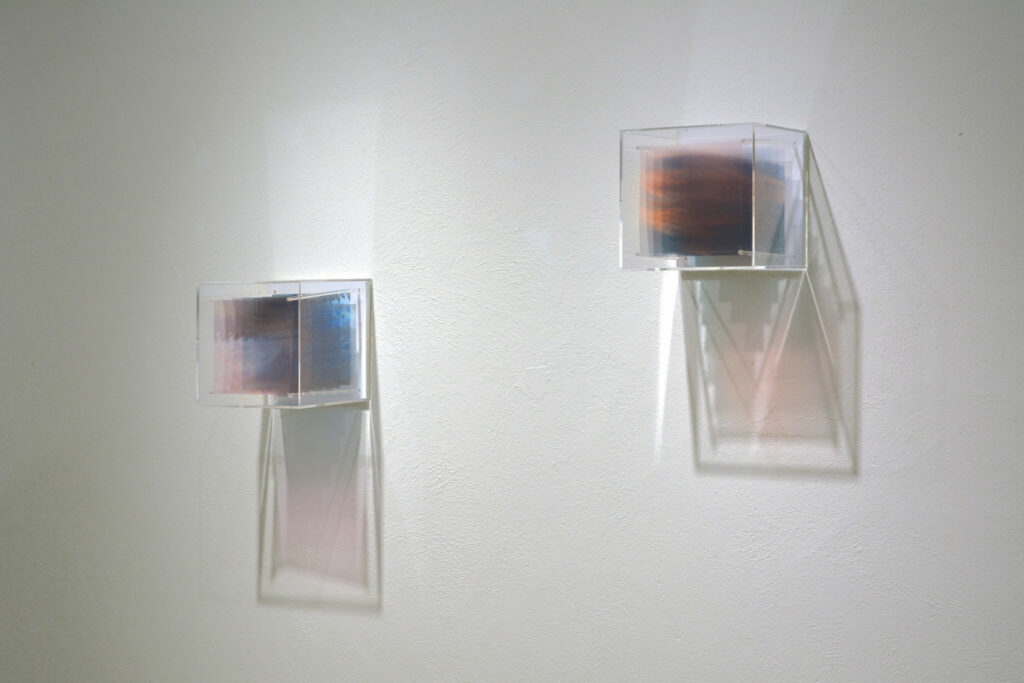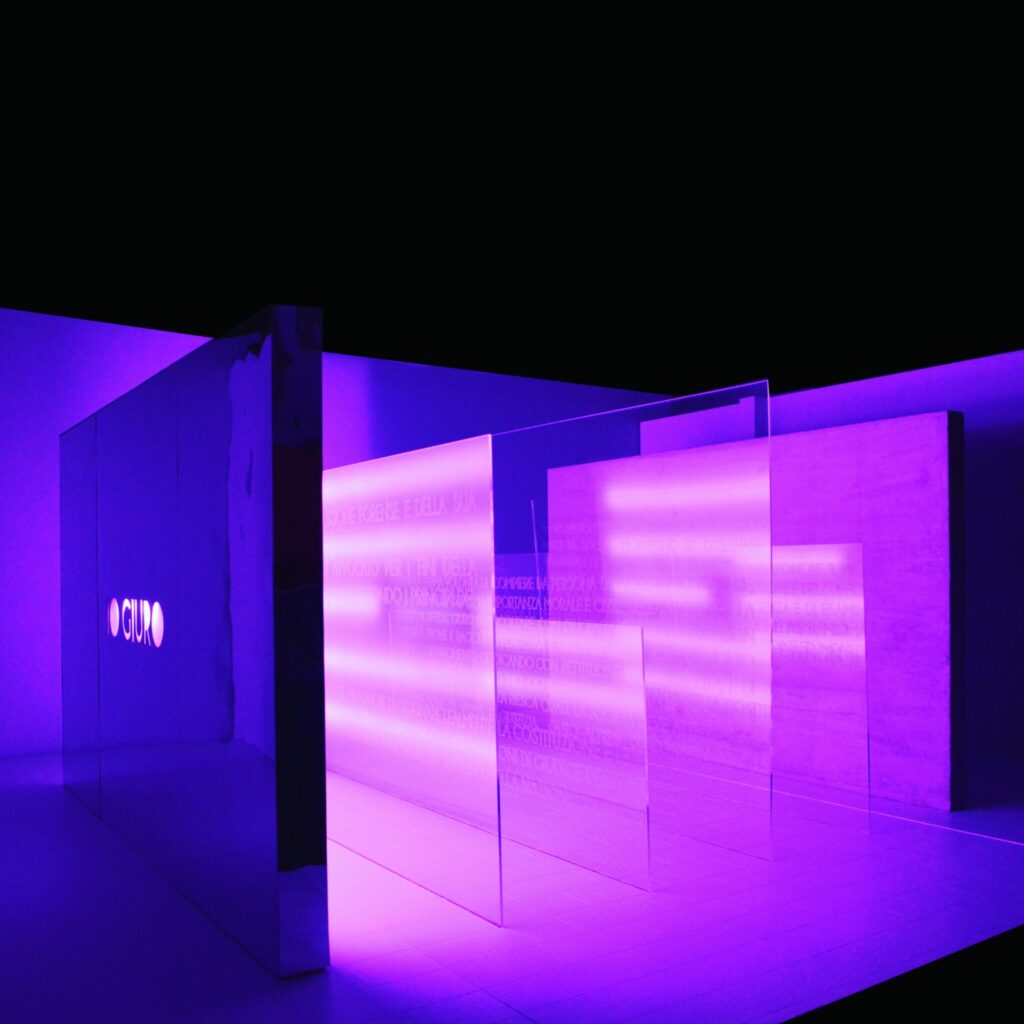In Between Dichotomies: Art by David Lascaris

Italian architect and visual artist of many mediums, David Lascaris, lives and works in Amsterdam. His artistic practice fluctuates between the essential contraries of transience and eternity, divinity and humanity, life and death, and he often finds himself exploring the spaces in between. Here, in his own words, he shares his inspirations and creative process.
The article is part of a series of interviews highlighting inspiring individuals and the passions that make them tick. It was originally published as part of our 2022 issue of Wall Stories Magazine for the September edition of the Maison & Objet trade fair in Paris.
David Lascaris is an architect, designer, and artist who’s found a unique creative voice informed by his astute architectural background and travels. His project Io Giuro was a finalist in the competition for an installation for the Palace of Justice in Florence, and he’s had the privilege of holding a solo exhibition at Fondamenta Gallery in Rome.
Upon seeing some of his stunning exhibits, we knew we had to ask David a few questions to discover the story behind his work and his inspirations. Here’s what we found out.
But before you dive in, we asked David to curate a selection of artworks by Displate artists for your home. Check out his picks and get inspired!

On the Origins Of His Creative Journey
I graduated as an architect, so my way of thinking is deeply influenced by architecture. My ideas always come from a concept of space which, for me, is essential. Space is not only a physical place, however, but also an existential one. This passage from architecture to art allowed me to understand how to develop the ideas I couldn’t fully express through architecture but rather through other freer forms of expression—precisely artistic ones.

My research develops through the use of different media and focuses on the themes of impermanence, the ephemeral, and, by contrast, the eternal.
On Exploring Philosophical Themes
I am fascinated by the themes of life and death and the relationship between the human and the divine.
I was greatly inspired by Alejandro Jodorowsky and his idea of exploring the unconscious as the portal to the divine ocean, where the soul is merely a drop. I got into his work when I read his visionary autobiography, The Dance of Reality. In the descriptions of Jodorowsky’s personal dream journeys, I found some of my own recurring dreams and nightmares.
On His Bill Viola Inspiration
Another artist who inspires me is Bill Viola. I share his obsession with this aquatic landscape that becomes a new world. It’s another dimension you can dive into and experience the numinous, something that’s alien to the manifestations of reality known to us.
On His Time In Beijing
Another important step in my journey was my stay in Beijing, where I lived for a year in 2012.
In Bejing, I experienced fragility, temporariness, and immateriality. Everything is instantaneous there, and nothing stays the same for long. In a hutong where I lived, living itself had become somehow immaterial. The houses are overcrowded, often without kitchens and with outdoor toilets only.
Although the wall is one of the fundamental elements in the grammar of Chinese cities, the line that separates public and private space is often transgressed. A single alley can become an extension of the domestic dimension.
Everything in Beijing finds its place on the road, which in turn acquires a series of continuous temporary meanings, collapsed into space but shifted in time. It’s a city that’s in the process of constant evolution. Having experienced Beijing, my ideas have become more ephemeral, more volatile, and somehow more uncertain. I usually choose materials that favor transparency or ones that are destined to wear out. Many of my works transform, evolve, and seem to move.
On Delving Into Impermanence, Nature, and Reality
I created a series of artworks called Apnea. It’s plexiglass boxes of various sizes that contain layers of underwater photographs printed on transparent acetate sheets. These layers overlap, break up, and blur the images, which in turn seem to be melting into a liquid, just like an aquarium.

The photographed reality reveals its impermanence by becoming ethereal and transparent. Shapes become more or less defined, depending on the movement of a spectator.
Here, too, spatiality is important: a two-dimensional photograph turns into three-dimensional space. This is not in a Trompe l’oeil illusion nor perspective breakthrough, as it happens through the superimposition of elements that never stop resembling themselves. However, the distance between the two levels means that the image is not uniquely linked to the third dimension but instead creates a place of distortion, immersing the eye. A viewer is forced to cross the transparency to find themselves in a heterotopic space with infinite possibilities and infinite overlaps.

Instead of being fixed, the image dematerializes and decomposes—it’s subject to continuous manipulation through the insertion of a temporal element, translated into a movement that’s separated from the artwork. Space reveals the nature of this relationship, of logos and divisions, all involving movement and time.
Take a look at an amazing selection of posters handpicked for you by David and other passion-driven individuals we interviewed, and give your walls the makeover they deserve!
On Mirrors and Moving Images
Another old project of mine is called Invisibilia and involves mirrors and moving images. I have always been fascinated by mirrors, both as instruments of divination and as instruments of heterotopia. A mirror can become a place where another dimension is suspended, a door to the mundus imaginalis, or even the world of unconscious depth that manifests itself through the superimposition of other reflections—just like in my project.
A mirror, therefore, shows us a world where we’re inseparably this and that, where we experience the other in ourselves, and where this other experiences us.
On The Fluido di Gender Exhibition
The installation, entitled Fluido di Gender, consists of an inverted plexiglass pyramid divided in half by an internal glass. One half is filled with a pink liquid and the other with a blue liquid – a metaphor for our static preconceptions about gender identity. The two liquids are totally distinct and separate. The pyramid is suspended over an aluminum tub filled with water.

From the tip of the pyramid, the color slowly drips into the tub, producing unexpected colored effects. What was previously perfectly defined and distinct thus becomes indeterminate and unexpected. This duality of antithetical concepts stems from limitations imposed by the human vision that tends to define boundaries to explain our reality. Meanwhile, our reality is fluid.
The colors, dripping into the tub, mix in an unpredictable performative process that doesn’t involve any human input. It’s like our sexuality and gender, which can only be contemplated in their unpredictability. The pyramid works like an hourglass, counting down the time until it’s completely empty.
On His Personal Home Decor Taste
I like many different things, shapes, and materials, from contemporary design to antiques. I especially love glass and materials that interact with light. Maybe a more minimalist mind would think that put together, those things don’t make sense, but they all come from my mind, so somehow, they do. I believe my taste is constantly evolving.

I don’t collect art myself, even though I wish I had the economic possibilities to do so. I would love to have paintings by Hernan Bas, my favorite painter. I mostly have my own art in my home decor; I even have a studio room that showcases most of my artwork. It’s this little gallery inside the house.
On What Sets His Work Apart From Other Artists
For me, art is simply a way to express what resides inside me, that which cannot easily be explained in words. In this materialistic society, we live in, where our reality is defined only as tangible and measurable, there seems to be no room for some form of spirituality, which for me is very important.
Death, life, transience, impermanence, the ephemeral, but also the eternal and the divine. I believe there is this in my works and in my projects. These subjects are universal, but my personal way of feeling is unique. And that’s what sets each artist apart from the others. All artists should just stay true to themselves!
Over to You!
Contemporary art is as much an experiment as it is a product. By playing with new ideas, artists can create something that’s both visually stunning and philosophically intriguing. And that’s exactly what we see in the work of David Lascaris. If you haven’t already, check out David’s Instagram account for more of his work!
If you made it this far, you might also enjoy other articles from our series:
All photos used in this post are © David Lascaris, used with permission.








